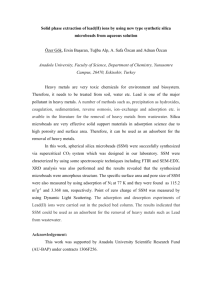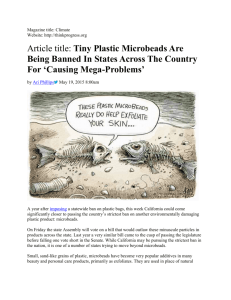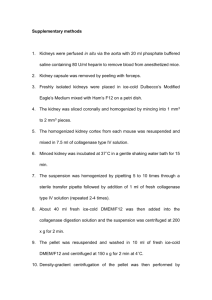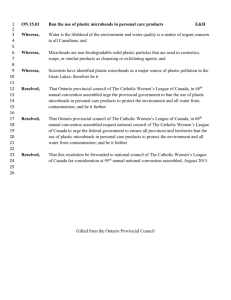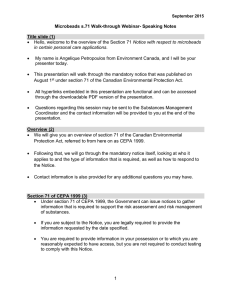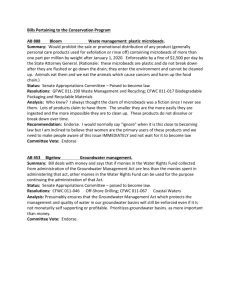Scientific Evidence Supports a Ban on Microbeads
advertisement
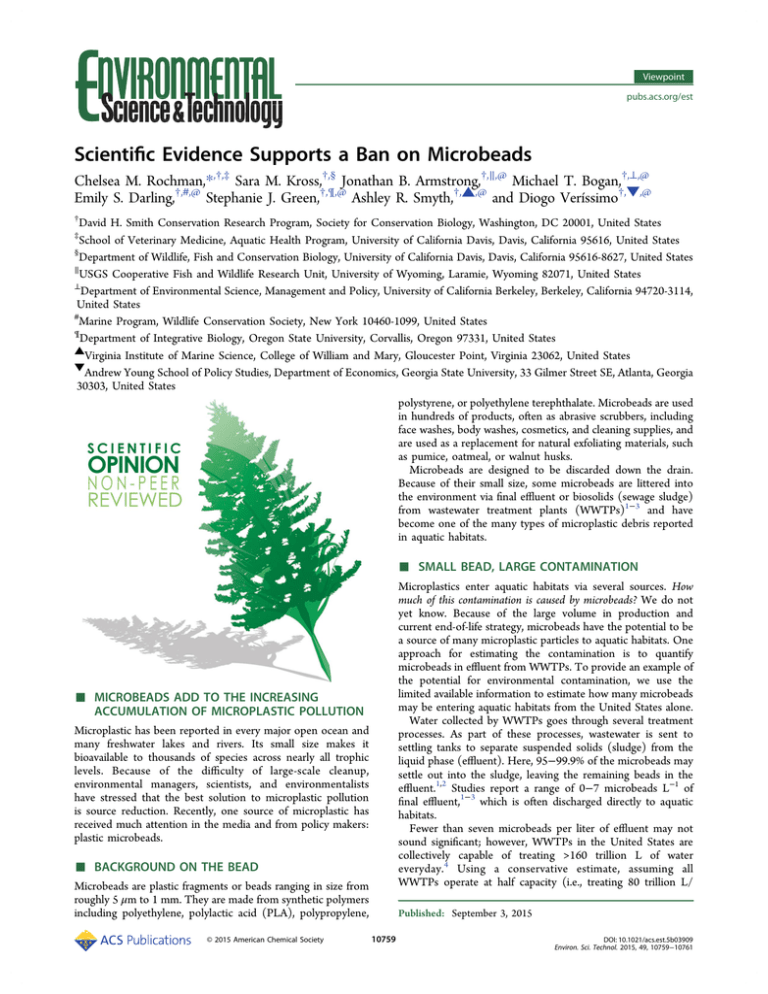
Viewpoint pubs.acs.org/est Scientific Evidence Supports a Ban on Microbeads Chelsea M. Rochman,*,†,‡ Sara M. Kross,†,§ Jonathan B. Armstrong,†,∥,@ Michael T. Bogan,†,⊥,@ Emily S. Darling,†,#,@ Stephanie J. Green,†,¶,@ Ashley R. Smyth,†,▲,@ and Diogo Veríssimo†,▼,@ † David H. Smith Conservation Research Program, Society for Conservation Biology, Washington, DC 20001, United States School of Veterinary Medicine, Aquatic Health Program, University of California Davis, Davis, California 95616, United States § Department of Wildlife, Fish and Conservation Biology, University of California Davis, Davis, California 95616-8627, United States ∥ USGS Cooperative Fish and Wildlife Research Unit, University of Wyoming, Laramie, Wyoming 82071, United States ⊥ Department of Environmental Science, Management and Policy, University of California Berkeley, Berkeley, California 94720-3114, United States # Marine Program, Wildlife Conservation Society, New York 10460-1099, United States ¶ Department of Integrative Biology, Oregon State University, Corvallis, Oregon 97331, United States ▲ Virginia Institute of Marine Science, College of William and Mary, Gloucester Point, Virginia 23062, United States ▼ Andrew Young School of Policy Studies, Department of Economics, Georgia State University, 33 Gilmer Street SE, Atlanta, Georgia 30303, United States polystyrene, or polyethylene terephthalate. Microbeads are used in hundreds of products, often as abrasive scrubbers, including face washes, body washes, cosmetics, and cleaning supplies, and are used as a replacement for natural exfoliating materials, such as pumice, oatmeal, or walnut husks. Microbeads are designed to be discarded down the drain. Because of their small size, some microbeads are littered into the environment via final effluent or biosolids (sewage sludge) from wastewater treatment plants (WWTPs)1−3 and have become one of the many types of microplastic debris reported in aquatic habitats. ‡ ■ SMALL BEAD, LARGE CONTAMINATION Microplastics enter aquatic habitats via several sources. How much of this contamination is caused by microbeads? We do not yet know. Because of the large volume in production and current end-of-life strategy, microbeads have the potential to be a source of many microplastic particles to aquatic habitats. One approach for estimating the contamination is to quantify microbeads in effluent from WWTPs. To provide an example of the potential for environmental contamination, we use the limited available information to estimate how many microbeads may be entering aquatic habitats from the United States alone. Water collected by WWTPs goes through several treatment processes. As part of these processes, wastewater is sent to settling tanks to separate suspended solids (sludge) from the liquid phase (effluent). Here, 95−99.9% of the microbeads may settle out into the sludge, leaving the remaining beads in the effluent.1,2 Studies report a range of 0−7 microbeads L−1 of final effluent,1−3 which is often discharged directly to aquatic habitats. Fewer than seven microbeads per liter of effluent may not sound significant; however, WWTPs in the United States are collectively capable of treating >160 trillion L of water everyday.4 Using a conservative estimate, assuming all WWTPs operate at half capacity (i.e., treating 80 trillion L/ ■ MICROBEADS ADD TO THE INCREASING ACCUMULATION OF MICROPLASTIC POLLUTION Microplastic has been reported in every major open ocean and many freshwater lakes and rivers. Its small size makes it bioavailable to thousands of species across nearly all trophic levels. Because of the difficulty of large-scale cleanup, environmental managers, scientists, and environmentalists have stressed that the best solution to microplastic pollution is source reduction. Recently, one source of microplastic has received much attention in the media and from policy makers: plastic microbeads. ■ BACKGROUND ON THE BEAD Microbeads are plastic fragments or beads ranging in size from roughly 5 μm to 1 mm. They are made from synthetic polymers including polyethylene, polylactic acid (PLA), polypropylene, © 2015 American Chemical Society Published: September 3, 2015 10759 DOI: 10.1021/acs.est.5b03909 Environ. Sci. Technol. 2015, 49, 10759−10761 Viewpoint Environmental Science & Technology Figure 1. Schematic diagram showing the route that microbeads take from our homes to the aquatic environment. there are applications (e.g., cosmetics, deodorants, lotions, nail polish, and cleaners) for microbeads that go down the drain but are not considered “personal care” or “rinse-off products”. Other issues include how the terms “plastic” and “biodegradable” are defined. For example, the legislation passed in Illinois defines “plastic” as something that retains its “defined shape during life cycle and after disposal”. This allows microbeads to be made from plastics that biodegrade slightly, thus changing their defined shape in an unspecified time period. What seems to cause the most confusion is how the term “biodegradable” is defined. Several companies and legislation promise to remove “non-biodegradable” microbeads from personal care products. When the term biodegradable is not defined or international standards for biodegradability are cited that do not mandate full degradation in aquatic environments, it allows for materials to be used in products that only degrade slightly during a 1-year period (e.g., PLA5). New wording should ensure that a material that is persistent, bioaccumulative, or toxic is not added to products designed to go down the drain. Preventing microbeads from becoming microplastic pollution will take time. In several debates, the argument has been raised that there is not yet enough scientific evidence to support banning microbeads. Though there are gaps in our understanding of the precise impact of microbeads on aquatic ecosystems, this should not delay action. Several extant questions regarding the persistence, fate, and hazards of microbeads can be addressed via more general studies of microplastic debris. Microplastics of the same type, size, and shape as microbeads are persistent, impractical to remove, and have negative impacts on aquatic organisms. The probability of risk from microbead pollution is high while the solution to this problem is simple. Banning microbeads from products that day) and that 0.1 microbeads are found per L of effluent (the average of the two studies which found a smaller amount of microbeads2,3), we calculate that 8 trillion microbeads per day are emitted into aquatic habitats in the United States (Figure 1). If you line these microbeads up side by side, assuming they are 100 μm spheres, the United States emits enough microbeads to cover >300 tennis courts daily. If we assume 99% of microbeads are captured during sedimentation, the remaining 800 trillion microbeads settle into the sludge. Sludge is often spread over areas of land and thus runoff from precipitation and irrigation may enable these particles to enter aquatic habitats (Figure 1). Such calculations clarify that waste management is not an effective solution to prevent microbead pollution. We must look upstream to prevent microbeads from entering WWTPs; this is best accomplished by removing microbeads from products. ■ THE MOVEMENT TO BAN THE BEAD Public support for banning microbeads is growing and has prompted action from multinational companies, NGOs, and policy-makers. For instance, Unilever, The Body Shop, IKEA, Target Corporation, L’Oreal, Colgate/Palmolive, Procter & Gamble, and Johnson & Johnson pledged to stop using microbeads in their “rinse-off personal care products”, and >70 NGOs from more than 30 countries are working on or helped pass legislative action to ban microbeads from personal care products. For example, several US states including Illinois, Colorado, Connecticut, New Jersey, Maine, Maryland, and Wisconsin and the province of Ontario in Canada have regulated or banned microbeads. While laudable, the agreements and legislation enacted thus far do not remove all sources of microbeads from the aquatic environment because of the wording of these documents. First, 10760 DOI: 10.1021/acs.est.5b03909 Environ. Sci. Technol. 2015, 49, 10759−10761 Viewpoint Environmental Science & Technology enter wastewater will ultimately protect water quality, wildlife, and resources used by people. ■ AUTHOR INFORMATION Corresponding Author *E-mail: cmrochman@ucdavis.edu. Phone: +1 (647) 770-8135. Author Contributions @ These authors contributed equally. Notes The authors declare no competing financial interest. ■ ACKNOWLEDGMENTS All authors were funded by the David H. Smith Postdoctoral Research Fellowship during preparation of this manuscript. Current policy information was provided by the Plastic Soup Foundation “Beat the Microbead” campaign. A. Kross helped produce the figure. We thank M. Dombeck, S. Gilliland Foster, S. Mason, K. Havens, S. Wilson, M. Morse, R. Doughty, M. Eriksen, B. Hartl, D. Parsons, T. Cox, all Smith Fellows who signed our associated policy brief (http://conbio.org/images/ content_policy/03.24.15_Microbead_Brief_Statement.pdf). Society for Conservation Biology, and the Cedar Tree Foundation for advising. ■ REFERENCES (1) Baltic Marine Environment Protection Commission HELCOM. BASE ProjectImplementation of the Baltic Sea Action Plan in Russia, Technical Report Published for IVL Swedish Environmental Research Institute, August 2014; Swedish Environmental Research Institute: Stockholm, Sweden, 2014. (2) Magnusson, K.; Wahlberg, C. Screening of Microplastic Particles in and down-Stream of a Wastewater Treatment Plant, Technical Report published for IVL Swedish Environmental Research Institute, August 2014; Swedish Environmental Research Institute: Stockholm, Sweden, 2014. (3) Martin, C.; Eizhvertina, O. Quantitative Analysis of Microplastics in WWTP Effluent in the Niagara Region, Technical Report published for Niagara College Environmental TechnicianField and Lab (co-op): Final Term Project, 2014; Niagara College Canada: Niagara-on-theLake, Canada, 2014. (4) U.S. Census 2000. Wastewater Treatment Facilities, 2006. http:// www.allcountries.org/uscensus/391_wastewater_treatment_facilities. html. (5) CalRecycle PLA and PHA Biodegradation in the Marine Environment, Technical Report published for Department of Resources Recycling and Recovery, Publication DRRR-2012-1435; Department of Resources Recycling and Recovery: Sacramento, CA, 2012. 10761 DOI: 10.1021/acs.est.5b03909 Environ. Sci. Technol. 2015, 49, 10759−10761
